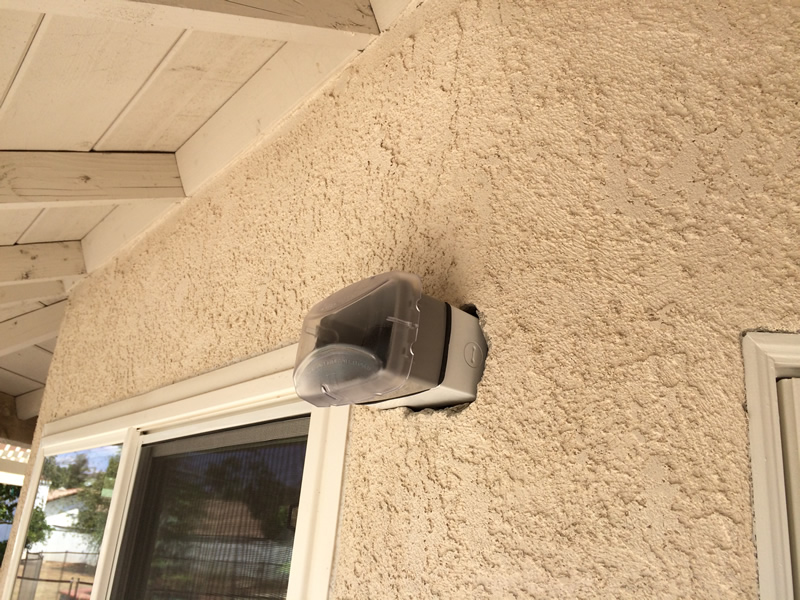Every time you go to the garden in the evening or want to find something in the garage before the morning going to work, you turn on the light. You do not think about how this electric current comes to the lamp, whether you need a ground fault circuit interrupter (GFCI) for outdoor lighting, and what is the principle of its operation.
But one day you have an electric shock, and it turns out that your house is not properly grounded. To avoid such unpleasant consequences in the future, it is important to know when it is necessary to install GFCI devices and how they work.
Outdoor Light GFCI - What Is It?

A GFCI is a device designed to protect people from electrical shocks. It works by immediately disconnecting the power supply if it detects an imbalance in the current flowing through the circuit. This can happen, for example, if you touch a live wire with one hand while simultaneously touching a grounded object with the other.
GFCI devices are usually installed in areas where there is a risk of electrical shocks, such as bathrooms, kitchens, and outdoor areas. In the US, all new homes must have GFCI outlets installed in these locations.
The principle of operation of the GFCI is based on the fact that the human body is a good conductor of electricity. If you touch a live wire with one hand and at the same time touch the ground (for example, a metal pipe or water tap) with the other hand, the current will flow through your body. This can cause an electric shock, which can be deadly in some cases.
GFCI devices are designed to prevent this from happening by constantly monitoring the current flowing through the circuit. If the GFCI detects an imbalance, it will immediately disconnect the power supply, preventing the current from flowing through your body.
Can You Run Power From a GFCI to a Light Switch?
Yes, you can generally connect more outlets to the LOAD terminals of a GFCI outlet for extra protection against ground faults. However, adding a switch may cause problems with inductive loads (items such as large motors), resulting in the GFCI being tripped unnecessarily. You should consult an electrician if you plan on adding a switch to a GFCI circuit.
Is There a Difference Between GFI and GFCI?
The difference between a ground fault circuit interrupter (GFCI) and a ground fault interrupter (GFI) is the same device's name. Although GFCI is more popular than GFI, both are interchangeable. So, in case you went to the shop and they didn't have GFCIs, you could ask for GFIs, and they would give you the same product.
Do You Need an Outdoor Light GFCI?
The National Electric Code (NEC) requires that all outdoor receptacles have a ground fault circuit interrupter, as stated in section 210.8. GFCIs are beneficial because they sense an imbalance and will automatically break the electrical circuit, preventing electrocution. As a matter of fact, the Electrical Safety Foundation International's research indicates that since GFCIs were first used in the 1970s, the yearly number of electrocutions has decreased by 83%!
It's important to note that GFCI devices must be tested regularly to ensure that they are working properly. You can test a GFCI by pressing the "test" button on the device. This will cause the power to be disconnected, and you should no longer be able to turn on the light. To reset the GFCI, simply press the "reset" button.
GFCIs, or ground fault circuit interrupters, are mostly used in places where there is a higher chance of water coming into contact with electricity. These areas could be kitchens or bathrooms, for example. In these locations, GFCIs help to prevent electrocutions from happening.
Where Do You Require GFCI?
GFCIs should be used for all 125-volt, single-phase 15 and 20 amp receptacles installed in the following locations:
- All outdoor receptacles: this means you will need an outdoor light GFCI not only for your floodlights but also for any other outdoor receptacles, such as those used for holiday lights.
- Receptacles serving pools, spas, hot tubs, and similar locations: people must understand that water and electricity don't mix. Therefore, any receptacles serving these locations must have a GFCI.
- Kitchens: all 125-volt, single-phase 15 and 20 amp receptacles installed in kitchens must be GFCIs.
- Garages and Workshops: all 125-volt, single-phase 15 and 20 amp receptacles installed in garages and workshops must also be GFCIs.
- Crawlspaces and Attics: any time you are working in an area that is not easily accessible, you should use a GFCI to protect yourself from electrical shocks.
Should Outside Lights Be on a Separate Circuit?
In the ideal model, outdoor lights should be on a separate circuit so that if there is a problem with the inside lights, the outdoor lights will not be affected. The circuit for the outdoor lights should also be insulated to protect it from the elements. This is especially important if you live in an area with severe weather conditions.
However, if you are not able to have a separate circuit for your outdoor lights, you can still protect yourself by using GFCI outlets. As we mentioned before, GFCIs will sense an imbalance and break the electrical circuit, preventing electrocution.
So, even though it's ideal to have a separate circuit for your outdoor lights, it's not absolutely necessary. Just be sure to use GFCI outlets to protect yourself from electrical shocks.
What Are The GFCI Outlet Requirements?
Ground fault circuit interrupter receptacles look very similar to standard household outlets. They have the same three-prong plug slots, plus two additional buttons that say ‘test’ and ‘reset.’ In order for a receptacle to be considered a GFCI, it must meet the requirements set forth by the National Electric Code. These requirements state that the outlet must:
- Be able to sense imbalances as low as 4 or 6 milliamps
- Have a short-circuit current rating of 6 amps or less
- Have a trip threshold between 20 and 30 milliseconds
In addition to these requirements, GFCI outlets must also be tested regularly to ensure that they are working properly. You can test a GFCI outlet by pressing the ‘test’ button. This will cause the power to be disconnected, and you should no longer be able to turn on the light. To reset the outlet, simply press the ‘reset’ button.
Criteria include that GFCIs should be accessible quickly for operation, renewal, or inspections without requiring personnel to utilize tools, climb over or remove impediments, or use portable ladders and so on. That is, they should not be installed behind sinks, inside cabinets, or in other locations where they would be difficult to reach quickly in an emergency.
Barrier-type GFCI devices have been developed that provide an additional level of protection against electrical shocks. These devices are designed to be installed in wet or damp locations and are equipped with an external barrier that protects the user from coming into contact with live parts.
How Can I Install GFCI?
The outdoor light GFCI installation process is not difficult, but it is important to make sure that you follow all of the instructions carefully. First, you will need to turn off the power to the circuit. Once the power is off, you can remove the old outlet and install the new GFCI outlet.
To wire the new GFCI, simply connect the black wire to the "hot" side of the outlet and the white wire to the "neutral" side. Finally, connect the ground wire to the green screw on the outlet. Once everything is wired correctly, you can turn on the power and test the GFCI by pressing the "test" button. If it trips, then it's working properly.
You should also test your GFCI outlets on a monthly basis to ensure that they are working properly. To test an outlet, simply press the "test" button. If the power is disconnected, then the outlet is working properly.

So, to sum it up, here is the step-by-step guide on how can you easily mount the outdoor light GFCI:
Step1.Turn off the power to the circuit.
Step 2. Remove the old outlet.
Step 3. Install the new GFCI outlet by connecting the black wire to the "hot" side of the outlet, and the white wire to the "neutral" side. Then, connect the ground wire to the green screw on the outlet.
Step 4. Turn on the power and test your GFCI by pressing the "test" button. If it trips, then it is working properly.
You can also perform monthly tests on your GFCIs just to make sure they are still in good working condition.
Can you replace GFCI with something else?
What if you don`t want to use GFCi, and still desire to protect the devices plugged in? You can replace GFCI with an Arc-Fault Circuit Interrupter (AFCI). An AFCI is very similar to a GFCI, but it protects against arc faults instead of ground faults.
An arc fault is an electrical problem that occurs when the current flowing through a circuit takes an unexpected path. This can happen if the wires are damaged or if there is a loose connection. Arc faults can be very dangerous because they can cause fires. That`s why it`s important to have an AFCI in your home.
Just like a GFCI, an AFCI will break the circuit when it senses an arc fault. This will prevent the current from flowing through the circuit and will prevent a fire from starting. You can buy an AFCI outlet at most hardware stores. They are not very expensive and are easy to install. So, if you don`t want to use a GFCI, you can replace it with an AFCI. Just make sure that you buy the right type of AFCI for your home.

Bottom line
Now you know everything there is to know about outdoor light GFCIs. You know what they are, why you need them, and how to install them. You also know that you can replace a GFCI with an AFCI if you don`t want to use one. Just remember to always follow the instructions carefully when installing or replacing an outlet. And, always test your outlets on a monthly basis to make sure they are working properly.